Mushrooms
Media
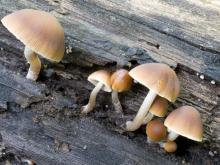
Species Types
Scientific Name
Various species of confusingly similar mushrooms
Description
Like the LGBs (“little gray birds”) of the birdwatchers, this is a catchall category. It includes all the small to medium-sized, hard-to-identify brownish mushroom with spores of all colors. There are many hundreds of species that fit this description!
Media

Species Types
Scientific Name
Urnula craterium
Description
Devil's urns are goblet-shaped, leathery brown cups. They grow in clusters on small to medium-sized decaying branches of hardwoods, especially oaks. Look for them in spring.
Media

Species Types
Scientific Name
Galiella rufa (formerly Bulgaria rufa)
Description
The hairy rubber cup has a reddish to brownish inner surface; the outside is blackish brown and hairy. It grows in clusters on dead deciduous wood.
Media

Species Types
Scientific Name
Sarcoscypha occidentalis
Description
The stalked scarlet cup is, indeed, a tiny red cup on a tiny white stalk. It grows scattered on fallen wet sticks and branches in damp deciduous woods.
Media
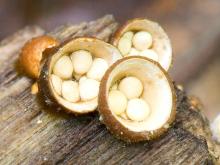
Species Types
Scientific Name
Crucibulum laeve
Description
Splash cups have small brown cups holding tiny “eggs” that are each attached to the “nest” by a cord. They grow in clusters on dead wood, debris, wood chips, and mulch.
Media
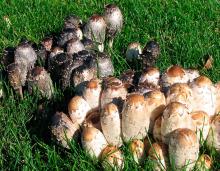
Species Types
Scientific Name
Coprinus comatus
Description
The shaggy mane has a white, shaggy, cylindrical cap that turns black and inky. It often grows in large numbers along roadsides and in lawns and disturbed areas.
Media
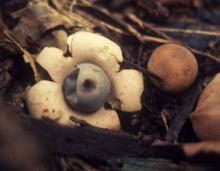
Species Types
Scientific Name
Geastrum species
Description
An earthstar is a roundish ball in the center of starlike rays. It grows on the ground in open woods.
Media

Species Types
Scientific Name
Lycoperdon perlatum
Description
The gem-studded puffball is a white, rounded to turban-shaped ball, densely covered with spiny warts, developing a pore at the top. It grows on the ground in open woods, along roads, in waste areas.
Media

Species Types
Scientific Name
Daedaleopsis confragosa (Daedalea confragosa)
Description
The thin-maze flat polypore is a grayish brown bracket fungus with a zoned top and a furrowed, mazelike underside. It grows singly or in small, layered clusters on dead wood or in wounds of living trees.
Media
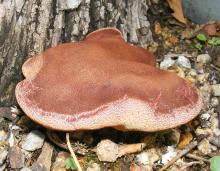
Species Types
Scientific Name
Fistulina hepatica
Description
The beefsteak polypore is a thick, semicircular, reddish or rusty, gelatinous bracket with a pinkish yellow underside. It grows at the base of living oaks and on stumps.
See Also



Media

Species Types
Scientific Name
Monotropa hypopitys
Description
Pinesap is a plant that puts the "wild" in wildflower! It lacks chlorophyll, so its roots connect to fungi underground and absorb nutrients from the fungi.
Media

Species Types
Scientific Name
Cladophora, Pithophora, and Spirogyra spp., and others
Description
Filamentous green algae forms green, cottony masses that are free-floating or attached to rocks, debris, or other plants.
Media

Species Types
Scientific Name
Monotropa uniflora
Description
Indian pipe lacks chlorophyll, so it is white, not green. Below ground, its roots join with fungi that connect to tree roots. This plant, then, takes nourishment indirectly from the trees.
About Mushrooms in Missouri
Mushrooms are a lot like plants, but they lack chlorophyll and have to take nutrients from other materials. Mushrooms are neither plants nor animals. They are in a different kingdom — the fungi. Fungi include the familiar mushroom-forming species, plus the yeasts, molds, smuts, and rusts.
Always be cautious when eating edible mushrooms. Be absolutely sure of the ID, and only eat a small amount the first time you try it to avoid a reaction..





















